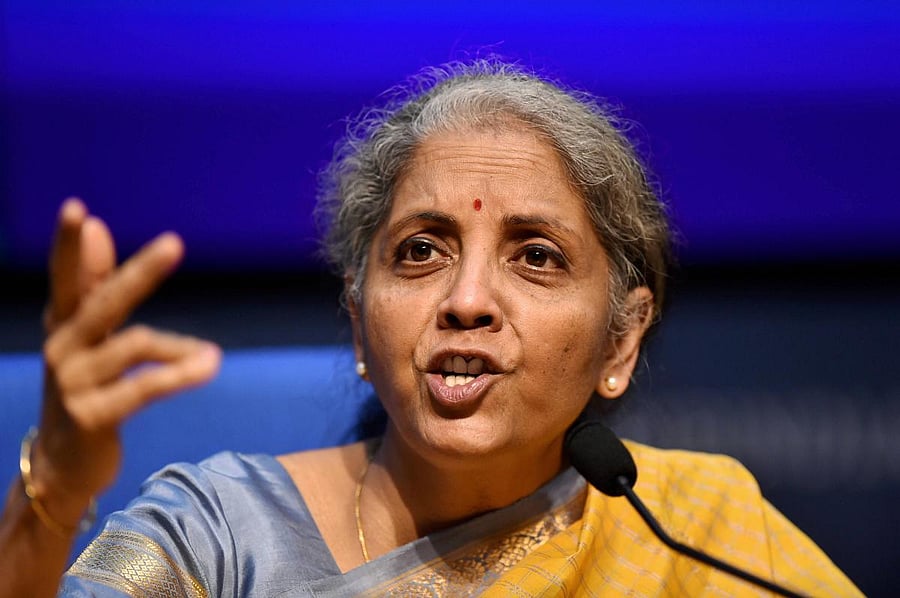
Finance Minister Nirmala Sitharaman on Monday said the government estimates fiscal deficit of 6.8 per cent of the gross domestic product (GDP) in the next financial year beginning April 1.
However, the fiscal deficit in 2020-21 is estimated to soar up to 9.5 per cent due to rise in expenditure on account of the outbreak of Covid-19 and moderation in revenue during this fiscal year.
The lockdown to check the spread of virus adversely impacted the economic activities resulting in contraction in the economy by an estimated 7.7 per cent.
Fiscal deficit is an indication of the government's borrowing to meet the shortfall between expenditure and receipts from taxes and other sources.
The deficit had soared to a high of 4.6 per cent of the GDP in 2019-20, mainly due to poor revenue realisation.
The government will borrow Rs 12.05 lakh crore from the market in 2021-22, lower than the Rs 12.80 lakh crore estimated for the current financial year.
"The gross borrowing from the market for the next year would be around Rs 12 lakh crores. We plan to continue with our path of fiscal consolidation, and intend to reach a fiscal deficit level below 4.5 per cent of GDP by 2025-2026 with a fairly steady decline over the period," Finance Minister Nirmala Sitharaman said while unveiling Budget 2021-22 in Lok Sabha on Monday.
Gold - Customs Duty
The government also announced cut in import duty on gold and silver, a move that will help bring down prices of these precious metals in the domestic market and boost exports of gems and jewellery.
The duty was reduced on other precious metals including gold dore bar, silver dore bar, platinum, gold/silver findings, and precious metal coins.
Agri Cess and Oil pipelines monetisation
Instead, her Budget for the 2021-22 fiscal tweaked excise duty structure to accommodate an agriculture infrastructure development cess, whose accruals would not be shared with the states.
Agri Cess will also be imposed on the import of certain items (like apples, peas, lentils, alcohol, chemicals, silver and cotton) to finance agricultural infrastructure and other development expenditure.
Besides the tweak, the Budget proposed monetisation of oil and gas pipelines of gas utility GAIL and oil refiners Indian Oil Corporation (IOC) and Hindustan Petroleum Corporation Ltd (HPCL).
Expenditure
Finance Minister Nirmala Sitharaman in the Budget proposed a sharp increase in expenditure on infrastructure, doubling of healthcare spending and raising of the cap on foreign investment in insurance in her Budget for the next fiscal in a bid to pull the economy out of the trough.
The budget documents showed that the revised capital expenditure for 2020-21 was pegged at Rs 1,34,510 crore as against last year's budgetary allocation of Rs 1,13,734 crore to reflect the additional expenses.
According to the documents, a total of Rs 1,35,060 crore has been set aside for capital expenditure that includes purchasing new weapons, aircraft, warships and other military hardware.
The Defence Ministry go the biggest bite, with the allocation for the Defence services increased to Rs 4.78 lakh crore compared to Rs 4.71 lakh crore in the 2020-21 budget.
The Budget for the fiscal year beginning April made no changes in personal or corporate tax rates but raised customs duties on certain auto parts, mobile phone components and solar panels in order to provide impetus to domestic manufacturing.
The Centre also cut back the budgetary allocation for rural development, which includes a jobs guarantee program, spending for rural roads and pension for widows, by 10% to Rs 1.95 lakh crore in the year starting April.
It has allocated Rs 73,000 crore to the rural employment guarantee programme MGNREGA for the next fiscal 2021-22, substantially lower than the actual expenditure of Rs 1.11 lakh crore in the current fiscal which included an additional Rs 40,000 crore for the scheme given by the government in the wake of the pandemic's impact on the economy.
Ujjwala scheme of providing free cooking gas to poor women will be extended to 1 crore more beneficiaries.
The capital outlay for 2021-22 is an increase of 18.75 percent compared to last year's allocation of Rs 1,13,734 crore.
(With inputs from PTI)
